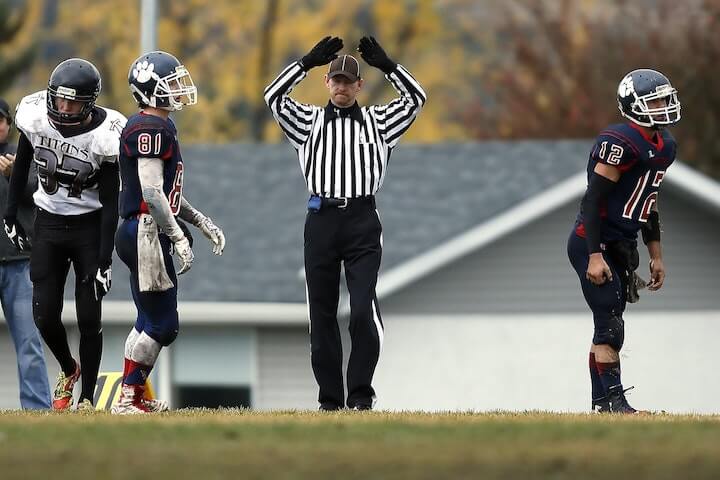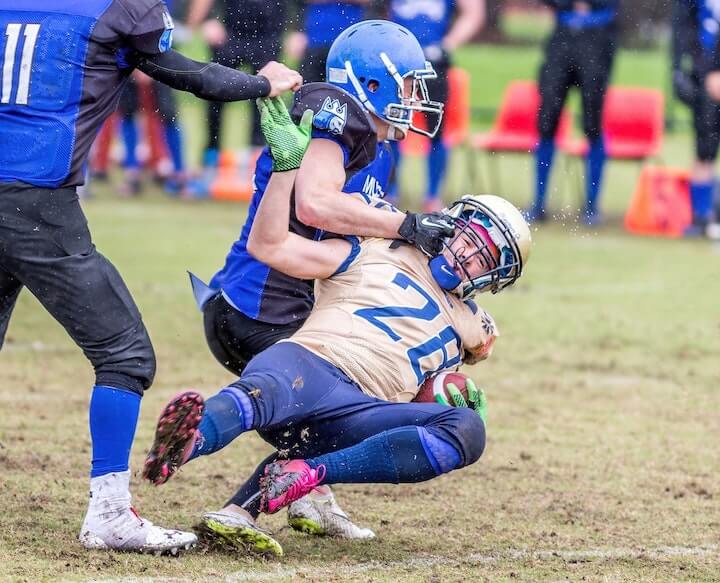During a football game, you may hear announcers say a referee has thrown a flag.
If you're new to the game, this may seem foreign and confusing to you, since you almost definitely didn't see someone on the field throw a big flag during the play.
A flag in football refers to a penalty flag that referees throw to the ground to signal that a team has committed a penalty.
It's likely that at some point when watching a game, you've noticed one of these yellow flags on the ground. Or you've at least noticed a referee picking up one of these yellow flags from the ground after a play.
But, what does a flag in football actually mean, and how do leagues use them in games?
Below, we'll dive deeper into these topics to give you a better understanding of how it all works.
What is a Flag in Football?
A flag in football is an object that referees throw whenever they spot a team commit a penalty.
The flag is yellow and made mostly of nylon.
They have a weight in them, which consists of sand in a plastic bag that's then sewn to the inside of the flag.
Flags are a universal symbol that one team has committed a penalty, though simply seeing a flag thrown doesn't tell you which team committed it.
After the play is over, the referee will confer with the official who threw the flag, and the referee will then announce the penalty to the stadium.
Officials carry these yellow flags in their back pockets or on their waistband, and then take them out to throw them when they notice a penalty.
There are different penalties officials can call, and we'll break down below what those are and how they throw the flags as a result.

Pre-Snap Flags
Penalties that occur pre-snap are those that happen BEFORE the center snaps the football to start the play.
Some of the most common pre-snap penalties include false starts, illegal formations, illegal shifts, delay of game, and too many players in the huddle -- on the offensive side.
On the defensive side, pre-snap penalties include encroachment, offsides, neutral zone infraction, and too many players on the field.
All of these pre-snap infractions result in a penalty of five yards, and the down remains the same -- since the down never actually happened.
The only exception to this rule is if the defensive pre-snap penalty results in a first down for the offense. For example, if the defense commits a too many players on the field penalty and it's 3rd-and-4, the five-yard penalty will result in a first down for the offense.
When an official spots a pre-snap penalty, he will throw his yellow flag high into the air. They do this to make it clear that a penalty occurred.
Depending on which penalty the official calls, he may also immediately start blowing his whistle, waving his arms over his head and running in toward the ball. This happens whenever the pre-snap penalty results in a dead ball.
For example, when the offense commits a false start, the play halts immediately and the penalty gets assessed.
For some defensive offside penalties, though, the play will resume and then the team will receive the penalty after the play. This gives the offense the choice to either accept or decline the penalty based on the outcome of the play.

Post-Snap Flags
Post-snap penalties are penalties that occur AFTER the snap of the ball. In other words, these are penalties that occur while the play goes on.
Most of the main offensive post-snap penalties result in a loss of 10 yards and repeating the current down.
Some of these include holding, clipping, block in the back, offensive pass interference, and illegal hands to the face.
Defensive post-snap penalties will range anywhere from a loss of 5 to 15 yards, and almost all of them will result in the offense getting an automatic first down -- no matter what the previous down-and-distance was.
Some of the most common defensive post-snap penalties are face masking, pass interference, defensive holding, roughing the passer, and illegal contact.
When an official spots a post-snap penalty, he will throw his yellow penalty flag to the spot of the foul.
This is where it's important that the flag is weighted, as it needs to be able to glide through the air as if it were a ball.
The referee needs to throw the flag near the spot of the foul, since some of these post-snap penalties will be assessed from that spot, rather than from the original line of scrimmage.
If the referee isn't able to throw the flag exactly where the foul occurred, it's OK, as he will just go over to the flag after the play and move it with his hands to the actual spot.
Conclusion
A flag in football is a yellow nylon flag with a bag of sand in it serving as a weight.
All officials in the game carry one on their body and physically throw them in the air or on the ground whenever they spot a penalty.
This happens whether the penalty has been committed before the snap or after it, though how they throw the flag depends on when the penalty occurred.

